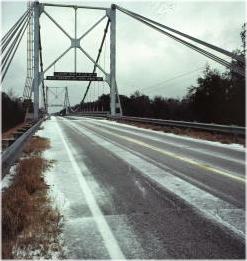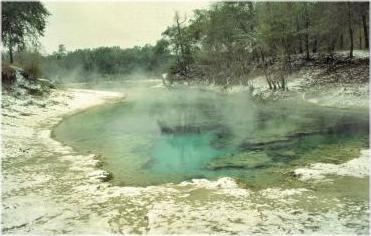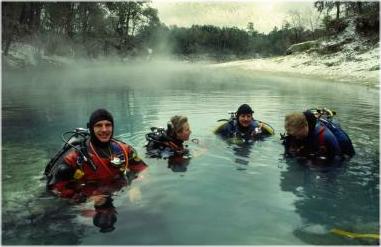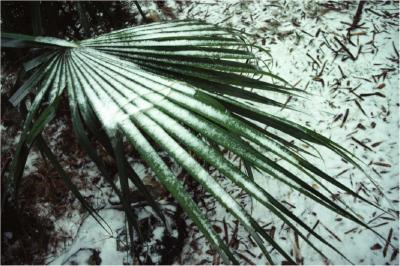 |
 |
|
Ice down upon the Suwannee River |
Ice and snow on the banks of the Little River Cave Entrance |
Florida Snowstorm
by
Larry "Harris" Taylor, Ph.D.
This material is copyrighted and
all rights retained by the author. This article is made available as a service
to the diving community by the author and may be distributed for any
non-commercial or Not-For-Profit use.
All rights reserved.
Go To: Home About "Harris" Articles War Stories Editorials Links Fini
We participate in a sport where it is impossible to define all the possible scenarios.
For example, I have never heard the Florida tourist people brag about
wind chill factors of -22 oF
with ice and snow closing their interstate highways. Nor have I heard anyone sing about the
icy banks along the Suwannee River. But it happened in 1989. I was there. It
came near the end of my
formal cave dive training. During the last few days of this experience the air
temperature dropped significantly and snow began to fall. Because the air
temperature was so frigid, we started going to laundry facilities to dry our wet
suits between dives to minimize our exposure in wet neoprene to the ever
decreasing wind chill factor. The weather degraded into one of
the worst snow storms in Florida history. Because the water temperature was
still in
the low 70's F and we knew there would be more than a hundred feet of stone
between us and the nasty winter above, we all agreed to do our planned graduation
dive. Our
belief was that the underwater conditions were much better than the surface
(often the case in diving, even without a hundred feet of stone protecting you)
So, with surface air temperatures in the low 20's F, we prepared our gear in the
comfort of our motel for a
stage bottle (drop cylinder) penetration of the Little River Cave System. The good news was that our scuba tanks
were eventually filled in an outdoor bath and equilibrated for about an hour. We had to
skim the ice from the surface of the water to retrieve our tanks. So, when we
went into the water, our SPG's showed a significant pressure increase. It is
the only time in my life where the pressure in the tanks increased when I
entered the water. I won't tell you how much, because if I did, Bill High
(Founder & President of Professional Scuba Inspectors) would hurt me!
Because
the air was so frigid, we opted to change into our wet suits in the motel. This
was our strategy to avoid pre-dive hypothermia during changing into our dive
gear. After all, the wind chill factor by this time was below -20 oF
. On
our way to the dive shop to fill our cylinders before our Little River dive, we stopped and had breakfast. I gather,
from the looks we received, that 5 guys wearing rubber emerging out of a snow
blizzard was not a typical Florida morning. After a great breakfast, as we left, I heard
one of the waitresses say, "Madge, them boys ain't too bright!"
We had both the parking lot and the cave system to ourselves.
Anyone who has been in Little River Cave System, especially before Table Rock was damaged will tell you what a special place this cave can be. The iridescent blue water, the cream colored, crater-covered walls and narrow tunnels allow the imagination to easily assume a peaceful journey exploring some lunar vault or tranquil alien asteroid-like environment rather than being earth-bound in a cave. The use of drop cylinders allowed a lengthened stay and greater penetration. It was one of the most pleasurable couple of hours I have ever spent submerged in Planet Ocean! (Thanks Steve, Vince and every member of the Florida cave community we met for one intense, awesome and absolutely fantastic couple of weeks of diving! One of the best in-water educational experiences I have ever known. Also, I had heard of Southern hospitality, but for these guys to bring down a blizzard for us "Snow Birds" to feel at home was truly exceptional (g))
The points of this story are:
1. Mother Nature rules and it is not always possible to predict all possible scenarios
2. Sometimes the difference between the tragedy of not-diving and an awesome once-in-a-lifetime-experience is the flexibility to safely alter standard protocols.
3. To increase your diving opportunities, explore as many specialties as time, location & finances permit. Each new skill & experience adds to your ability to play.
and finally,
4. Not everyone has the "fashion sense" to appreciate a well-dressed, wet suited diver! (g)
Photos Documenting The Florida Ice and Snow
 |
 |
|
Ice down upon the Suwannee River |
Ice and snow on the banks of the Little River Cave Entrance |
 |
 |
|
Buddies & Instructors posing in the snow prior to dive |
Snow on a palm leaf |
Go To: Home About "Harris" Articles War Stories Editorials Links Fini
About The Author:
Larry "Harris" Taylor, Ph.D. is a biochemist and Diving Safety Coordinator at the University of Michigan. He has authored more than 200 scuba related articles. His personal dive library (See Alert Diver, Mar/Apr, 1997, p. 54) is considered one of the best recreational sources of information In North America.
Copyright 2001-2024 by Larry "Harris" Taylor
All rights reserved.
Use of these articles for personal or organizational profit is specifically denied.
These articles may be used for not-for-profit diving education